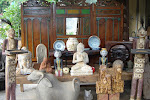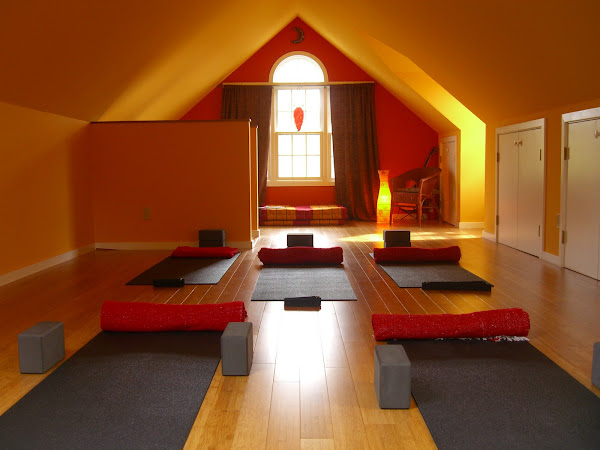
These days at The Karma Garage we are paying a lot of attention to our knees. And by paying attention, I mean that we are strengthening and stretching all of the muscles that cross these wondrous hinges. With balanced strength and flexibility across a joint, we gain stability – especially appreciated, if underneath all these muscles, our ligaments are in any way compromised.
Lets see how one pose can be used to strengthen all four muscular walls of the knee. I give you - Utkatasana.

In this powerful pose, we have the quadriceps in the front, working to hold the knees in place, and the hamstrings in the back, working to hold the hips in place. If we then add a yoga block between the thighs (and we do - just ask Jim), we can enhance the work of the inside thigh muscles. We can then remove the block and strap a yoga belt around the thighs (oh yes we can!) to get the outside muscles working. Yee Haaaaaa!
But here's the key. The feet must be balanced.
All the strengthening work in the world will offer our knees very little benefit if our knees are not aligned, and as usual, alignment begins where our feet hit the ground.
In yoga we place a lot of value in developing awareness of the four corners of each foot – one at the base of the big toe, one at the base of the pinky toe, and two at the back “corners” of the heel. If we balance our weight distribution evenly over these four corners, our arches will be honored, our ankles will be supported in neutral, and they will then be in an excellent position to better inform our knees.
Awareness of the four corners of each foot benefits us, when we do things like.... squeeze a block between our thighs in utkatasana. : ) The first thing you may notice in this endeavor is that you lose pressure through the outside corners of the feet, and then, because everything in our bodies is connected, the medial arches of the feet will begin to collapse, after which the insides of the knee joints will begin to gape, and the medial collateral ligament of each knee will be on its way to laxity; a state of instability, which is an unfortunate predisposition for degeneration of the knee joint surfaces - aka - arthritis. So we ground the outside corners of the feet a bit more, thus learning to take very good care of our knees.
You can imagine that when we do the opposite work, pressing outer thighs into a yoga belt, it is likely that we will lose grounding of the inside corners of the feet. The job becomes to exert more pressure through the inside corners.
We are doing the work of yoga. We are getting curious about making connections between opposites: the outward movement of the thighs with the increased need for grounding of the inner corners of the feet. We discover balance - alignment - stability - awareness - and so much more.
The beauty of this lesson is that it transfers to every standing pose in yoga - every single standing pose. And actually? The four corners of our feet give us very important information even when we turn our selves upside down. Most importantly, we can take this information off the mat, and try it out in "real life". I invite you to take this lesson on as your experiment. Even now! While you're sitting down at this computer! (Did your spine just lengthen?)
Onward.... What about balancing flexibility all around the knees?
1. Down dog to stretch your hamstrings and gastrocs (calf muscles).

2. Pigeon variation (eka pada kapotasana variation) to stretch your quads.
(Please feel free to drop that right arm and hold the left ankle in your hand or use a yoga belt to catch the ankle)

3. Revolved triangle (parivritta trikonasana) to stretch the outside muscles (iliotibial tract).

4. Straddle pose (upavista konasana) with legs up the wall to stretch the inside muscles (long adductors).

All of these poses can be varied to accomodate your needs. Please never take any written advice as a prescription. Instead, you can try these poses on to see if they fit you, adding props to preserve alignment and offer support. Have a conversation with these poses, listening very closely to your body, engaging your body with a spirit of curiosity and compassion. Please, take any questions you still have to class. Of course you are also very welcome to dialogue here.
Now.... It is time to connect the knees to the hips.
In many ways, the hips are like the parents of the knees, dictating what is safe for our knees to do - especially in yoga class. Unfortunately too many yoga students have taken their knees into poses like lotus and hero pose without the hips' permission. The knees were just minding their own bees wax, when they got forced somewhere they could not go, and they certainly suffered the consequences.
Take lotus (padmasana).

Here, if the hips do not have sufficient external rotation (rolling out of the thigh bones), the lateral collateral ligaments of the knees will find it for us - by overstretching or even tearing. Pinching the medial meniscus is another possible scenario. There's cartilage damage to be done. And muscles to be strained - like the possibly overzealous sartorius or adductor longus taking on more than it can handle.
You don't have to tease all these possibilities apart. What you do have to do is listen to and respect your body. The knees know. The knees know.
On to hero pose (virasana).

If you have enough knee flexion to actually sit down between your shins, the question becomes - do you really have enough internal rotation at the hips (rolling in of the thigh bones), because if you don't (and many of us don't - it's anatomical)...the medial collateral ligament may accommodate your wishes by overstretching and possibly even taking a bit of meniscus along for the ride. Again - ask your knees. If there is pain, especially along the inside of the knee joint, you must back off. It may help to sit up higher on a block or two, and also, it's very important to keep your shin bones tucked in close to your thigh bones with your ankles in neutral.
Well, we have begun a conversation about knees here. And I believe I will continue this line of thought into the next blog - perhaps something about the vastus medialis obliquus - because you know - I really care about your patella tracking, too.
And also because - I think you're the bees knees.






4 comments:
This is wonderful - thank you! My right knee gives me problems from an old dance injury, so this is great information for me.
You're welcome, Carol.
Very glad you dropped by!
Wonderful, Val. Very interesting. Now...would you like to write a post about hips? I could use all the help I can get. Here are my sketchy details using my limited yoga vocabulary:
I think for most of my life I have not understood just how the flexibility (or lack there of) of my hip affects my posture, which of course affects my view of the world. When you look down, all you see is ground, right? So after 9 months of yoga, learning literally how to stand (which when you have as many leg issues as I do doesn't come naturally--though I think many people don't know) through mountain pose, I used my yoga training to stand up straight during my father's funeral. I was standing during the funeral, concentrating on my posture and it helped tremendously. To stand up straight. To be strong. (Whoa that was a tangent.) But I still struggle with tightness in my hips that I think causes me to walk and stand with a slight pike position. Lunges and pigeon and figure 4 (is that right?) help, but I'd have to do these daily I think to have them really help...and I'm not yet that dedicated to my home practice. The tightness affects my ability to do the warrior and forward fold positions...meaning the tightness keeps me from being able to stabilize my body (like keeping my body facing front during triangle pose) or relax into the position. Because tucking the tailbone down is so essential to so much, having tight...um...hip flexors?...makes that difficult. Which...all of it seems connected to things that are difficult in my life. Basic things. Like walking and sex and feeling powerful in my physical self.
Sally
Sally, this comment is mucho delicioso! I am going to sink right into it ASAP - hopefully this weekend. Thank you so much for getting my cogs going. Oh how you indulge me!
I will come back with a few questions first. Of course! : )
Val
Post a Comment